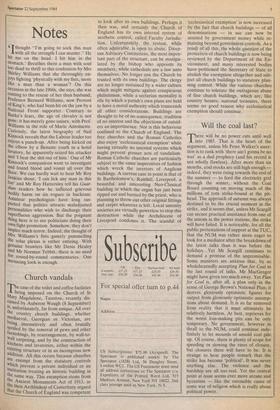Church vandals
The case of the toilet and coffee facilities being imposed on the Church of St Mary Magdalene, Taunton, recently dis- cussed by Auberon Waugh (8 September) is, unfortunately, far from unique. All over the country church buildings, whether mediaeval, Georgian or Victorian, are being insensitively and often brutally spoiled by the removal of pews and other furnishings, by rearrangement, by wall-to- wall carpeting, and by the construction of kitchens and lavatories, either within the existing structure or in an incongrous new addition. All this occurs because churches are exempt from the statutory controls which prevent a private individual or an institution treating an historic building in the same way. This exemption stems from the Ancient Monuments Act of 1913, as the then Archbishop of Canterbury argued that the Church of England was competent
to look after its own buildings. Perhaps it then was, and certainly the Church of England has its own internal system of aesthetic control, called Faculty Jurisdic- tion. Unfortunately, the system, while often admirable, is open to abuse. Dioce- san Advisory Committees, the most impor- tant part of the structure, can be manipu- lated by the bishop who appoints its members, while cathedrals are a law unto themselves. No longer can the Church be trusted with its own buildings. The clergy are no longer sustained by a wider culture which might mitigate against conspicuous philistinism, while a sectarian mentality is rife by which a parish's own plans are held to have a moral authority which transcends all other considerations. Buildings are thought to be of no consequence, tradition of no interest and the objections of outsid- ers an impertinence. Nor is this behaviour confined to the Church of England. The free churches and the Roman Catholics also enjoy 'ecclesiastical exemption' while having virtually no internal systems which might prevent grosser acts of vandalism. Roman Catholic churches are particularly subject to the same imperatives of fashion which wreck the interiors of Anglican buildings. A current case in point is that of St Bartholomew's, Rainhill, Liverpool, a beautiful and interesting Neo-Classical building in which the organ has just been ripped out and burned by the priest, who is planning to throw out other original fittings and carpet whatever is left. Local amenity societies are virtually powerless to stop this destruction while the Archdiocese of Liverpool condones it. The scandal of
'ecclesiastical exemption' is now increased by the fact that church buildings — of all denominations — in use can now be assisted by government money while re- maining beyond government controls. As a result of all this, the whole question of the protection of church buildings is now being reviewed by the Department of the En- vironment, and many interested bodies have petitioned the Secretary of State to abolish the exemption altogether and sub- ject all church buildings to statutory plan- ning control. While the various churches continue to tolerate the outrageous abuse of fine church buildings, which are, like country houses, national treasures, there seems no good reason why ecclesiastical exemption should continue.










































 Previous page
Previous page